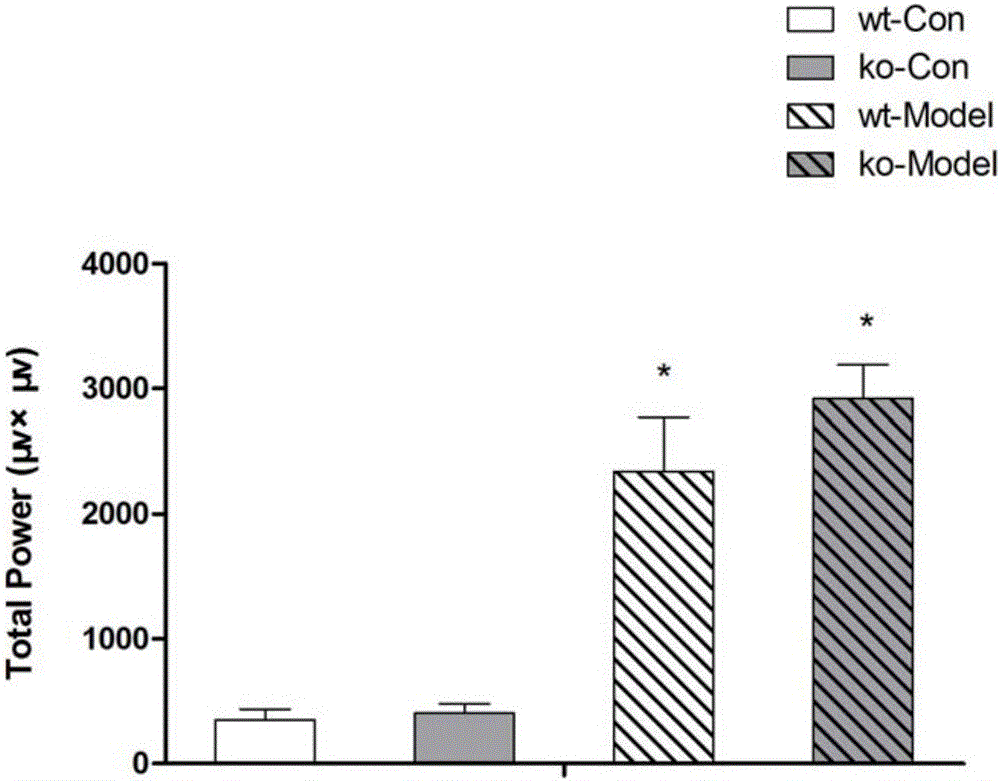Application of gama-aminobutyric acid (GABA) translocator isoform I gene knockout mouse system in building novel drug induced epilepsy animal model
An epilepsy animal, gene knockout technology, applied in gene therapy, pharmaceutical formulations, genetic material components, etc., can solve the problems of easy death induction effect between individuals, low induction success rate, low epilepsy grade and other problems, to achieve epilepsy susceptibility Increased effect, high induction success rate, high epilepsy grade
- Summary
- Abstract
- Description
- Claims
- Application Information
AI Technical Summary
Problems solved by technology
Method used
Image
Examples
Embodiment 1
[0024] 1. Materials
[0025] 1.1 Experimental animals
[0026] A total of 30 mice, all male. Among them, 15 GAT1 knockout mice and 15 C57 wild-type mice were purchased from Shanghai Southern Model Organism Research Center. The name of the GAT1 knockout mouse strain: B6.129-Slc6a1 tm1Srcmo , strain number: NM-KO-00002, knockout GAT1 gene NCBI number: 232333. Using the random grouping method, the weight of the mice in each group was comparable, and the specific grouping conditions were as follows:
[0027] 1) Normal saline control group (Control, n=14), including:
[0028] ①Wild-type control (wt-Con, n=7): only an equal volume of saline was injected intraperitoneally;
[0029] ② Genotype control (GAT1-Con, n=7): only an equal volume of normal saline was injected intraperitoneally.
[0030] 2) Epilepsy model group (Model, n=16), including:
[0031] ①Wild-type model (wt-Model, n=8): intraperitoneal injection of PTZ, 30mg / kg body weight;
[0032] ② Genotype model (GAT1-Model...
Embodiment 2
[0064] To investigate the reproducibility of the epilepsy model using GAT1 knockout mice. Divided into 3 batches, each batch of 10 GAT1 gene knockout mice, using the method described in Example 1 to prepare epilepsy models. The death rate and induction success rate of each batch of mice after modeling, the grade of epileptic seizures after the last intraperitoneal injection, and the total power of EEG of mice after modeling were counted.
[0065] Table 4 shows the statistical results of mouse mortality and induction success rate after each batch of modeling.
[0066] Table 4 Mouse mortality rate and induction success rate after modeling in each batch
[0067]
[0068] Table 5 shows the statistical results of the seizure levels of the last injection of mice after each batch of modeling.
[0069] Table 5 The number of samples of each batch of mice after intraperitoneal injection according to the behavioral grade of epileptic seizures
[0070]
PUM
 Login to View More
Login to View More Abstract
Description
Claims
Application Information
 Login to View More
Login to View More - R&D
- Intellectual Property
- Life Sciences
- Materials
- Tech Scout
- Unparalleled Data Quality
- Higher Quality Content
- 60% Fewer Hallucinations
Browse by: Latest US Patents, China's latest patents, Technical Efficacy Thesaurus, Application Domain, Technology Topic, Popular Technical Reports.
© 2025 PatSnap. All rights reserved.Legal|Privacy policy|Modern Slavery Act Transparency Statement|Sitemap|About US| Contact US: help@patsnap.com



